It’s Back; Tuesday Twitter Trivia – Tony Awards Special
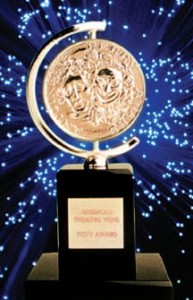 That’s right, after a nice long break and pilling up more and more swag to give out, the Tuesday Twitter Trivia is back! This week is a special Tony Award Trivia question. First, I would like to congratulate ALL of the nominees and of course the winners of the 2010 Tony Award in the categories. A special shout out goes to Kevin Adams, the lighting designer of American Idiot for winning Best Lighting Design of a Musical and Neil Austin, the lighting design or Red for winning Best Lighting Design of a Play. Although I have not seen either show, I have heard that the Tony’s are well deserved!
That’s right, after a nice long break and pilling up more and more swag to give out, the Tuesday Twitter Trivia is back! This week is a special Tony Award Trivia question. First, I would like to congratulate ALL of the nominees and of course the winners of the 2010 Tony Award in the categories. A special shout out goes to Kevin Adams, the lighting designer of American Idiot for winning Best Lighting Design of a Musical and Neil Austin, the lighting design or Red for winning Best Lighting Design of a Play. Although I have not seen either show, I have heard that the Tony’s are well deserved!
And now on to this weeks Tuesday Twitter Trivia…
Who has racked up the most Tony Awards during the course of their career?
Have the answer? Submit your answer via a reply to @isquint via Twitter. The first person back with the correct answer wins some great swag that I have been collecting from previous events and trade shows along with an iSquint button.
Tuesday Twitter Trivia Winner – CMY vs RGB
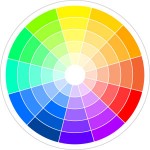 Yesterdays Tuesday Twitter Trivia was based on the previous days article about CMY rs RGB and their “theoretical” differences. The theory is that CMY and RGB values are directly opposite of each other when dealing with light. While it is not exactly correct, the theory is pretty close. Here is a recap of yesterdays Tuesday Twitter Trivia question:
Yesterdays Tuesday Twitter Trivia was based on the previous days article about CMY rs RGB and their “theoretical” differences. The theory is that CMY and RGB values are directly opposite of each other when dealing with light. While it is not exactly correct, the theory is pretty close. Here is a recap of yesterdays Tuesday Twitter Trivia question:
What is the “theoretical” CMY values for Pink with RGB values of 100%, 25%, 70%?
Lets take a closer look at the values and see exactly how the theory would hold up mixing this pink in CMY.
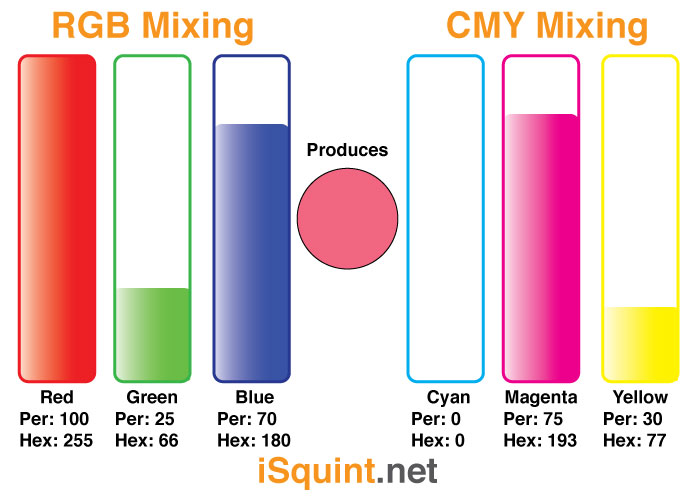
So who was the first in with the correct response, Michael Kohler, or better known on twitter at @MEKohler. Michael was the first one to @ reply with a response of C: 0%, M: 75%, Y: 30%. Michael wins himself a lovely little iSquint prize pack. Thanks all for playing and look for another Tuesday Twitter Trivia question next week.
Have a trivia question about lighting that you think will stump everyone? Send you trivia questions to me via the Contact Us page here on iSquint. You just might receive an iSquint prize pack!
Tuesday Twitter Trivia – CMY vs RGB
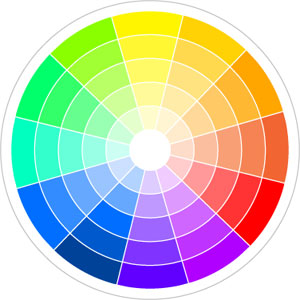 Tuesday is here once again and that means we are one day closer to the weekend. To help expand our minds and use the knowledge that we learn yesterday with RBG vs CMY values, this weeks Tuesday Twitter Trivia questions puts that knowledge into practice.
Tuesday is here once again and that means we are one day closer to the weekend. To help expand our minds and use the knowledge that we learn yesterday with RBG vs CMY values, this weeks Tuesday Twitter Trivia questions puts that knowledge into practice.
What is the “theoretical” CMY values for Pink with RGB values of 100%, 25%, 70%?
Know the answer? Send your response via an @ reply to @iSquint through twitter. The first person in with the correct response wins an iSquint prize pack. The winner will be announced tomorrow.
If you have a Tuesday Twitter Trivia question that you think will stump everyone, I would love to hear it. Send your trivia questions via the Contact Us page here on iSquint. You might just win a prize pack yourself!
Tuesday Twitter Trivia Winner – Limelight
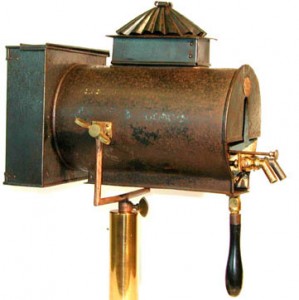 This weeks Tuesday Twitter Trivia took us back in time once again to see where the industry came from. So a quick recap from yesterday with the trivia question:
This weeks Tuesday Twitter Trivia took us back in time once again to see where the industry came from. So a quick recap from yesterday with the trivia question:
What is a Limelight and how does it work?
So what is a Limelight?
A Limelight is a type of stage lighting once used in theatres and music halls. An intense illumination is created when an oxyhydrogen flame is directed at a cylinder of quick lime (calcium oxide), which can be raised to 2572°C before melting. The light is produced by a combination of incandescence and candoluminescence. Although it has long since been replaced by electric lighting, the term has nonetheless survived, as someone in the public eye is still said to be “in the limelight.”
How about some history of the Limelight.
The limelight effect was discovered in the 1820s by Goldsworthy Gurney, based on his work with the “oxy-hydrogen blowpipe,” credit for which is normally given to Robert Hare. In 1825, a Scottish engineer, Thomas Drummond (1797–1840), saw a demonstration of the effect by Michael Faraday and realized that the light would be useful for surveying. Drummond built a working version in 1826, and the light is sometimes known as the Drummond Light after him.
Limelight was first used in public in the Covent Garden Theatre in London in 1837 and enjoyed widespread use in theatres around the world in the 1860s and 1870s. Limelights were employed to highlight solo performers in the same manner as modern followspots. Limelight was replaced by electric arc lighting in the late 19th century.
So who had the correct answer in yesterday via twitter. With the 140 character limit, Mr. Josh Allen or @JoshAllen was first in with an mention reply rather then than a direct message and wins a iSquint Prize Pack. Thanks for playing, look for more Tuesday Twitter Trivia next week and beyond here on iSquint.
Have an idea for a Tuesday Twitter Trivia question that might stump us? Send me your ideas via the Contact Us page on iSquint.
Thanks Wikipedia for the history lesson!
Tuesday Twitter Trivia – Limelight
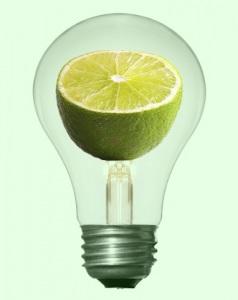 Tuesday is here once again and that means it is Tuesday Twitter Trivia Time! This week we are going back in history once again to see how much you know about were lighting came from. It is important to know where and how lighting got it’s start and how it shaped the industry that we love. So this weeks Tuesday Twitter Trivia question is:
Tuesday is here once again and that means it is Tuesday Twitter Trivia Time! This week we are going back in history once again to see how much you know about were lighting came from. It is important to know where and how lighting got it’s start and how it shaped the industry that we love. So this weeks Tuesday Twitter Trivia question is:
What is a Limelight and how does it work?
Last week I changed how to submit your response. Rather then sending a direct message through twitter, send an reply to @iSquint with your response. The first one in the the correct answer wins an iSquint prize pack. The winner will be announced tomorrow along with a little history of the question.
Have a Tuesday Twitter Trivia question that might stump us? Let me know by sending me a message through the Contact Us page here on iSquint.
Tuesday Twitter Trivia Winner – Single Source
 Yesterdays question was pretty simple right? Well, if you know your lighting history, it might have been. Quick recap from yesterday with the trivia question:
Yesterdays question was pretty simple right? Well, if you know your lighting history, it might have been. Quick recap from yesterday with the trivia question:
Which lighting designer once noted that they dream of a day when there would be a large enough light source, (ie: 10k fresnel), to bask the stage with a single light source to mimic a natural light source?
So who is this designer that wanted to light the stage with a single source of light… None other then Stanley McCandless. Mr. McCandless talked about this theory of lighting the stage in his book, A Method for Lighting the Stage.
There were still a number of people who still Direct Messaged their response, the winner with the correct response was Nick Malczewsky or @nickmalczewsky.
If you have the opportunity to pick up a copy of Mr. McCandless book, I highly recommend it! You can find used book sellers on Amazon.com. There is a lot of lighting history and knowledge in that book and well worth the investment regardless of your lighting experience.
If you have an idea for a future Tuesday Twitter Trivia, send them to me theough the Contact Us page here on iSquint. There just might be a prize pack in it for you!
Tuesday Twitter Trivia – Single Light Source
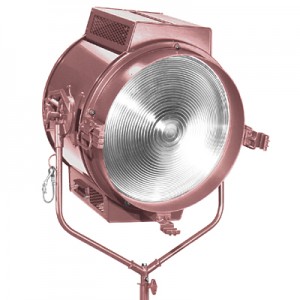 It must be Tuesday as it is time for the Tuesday Twitter Trivia. This weeks trivia question takes us back to lighting history. If you remember from your intro into lighting or theatre history classes, this week question should be simple enough.
It must be Tuesday as it is time for the Tuesday Twitter Trivia. This weeks trivia question takes us back to lighting history. If you remember from your intro into lighting or theatre history classes, this week question should be simple enough.
Which lighting designer once noted that they dream of a day when there would be a large enough light source, (ie: 10k fresnel), to bask the stage with a single light source to mimic a natural light source?
Know who that designer was? I am going to change it up a little bit this week. If you know the correct response at reply iSquint via twitter, @iSquint rather then direct messaging. This weeks winner will receive an iSquint prize pack. Good luck!
Do you have a Trivia question that you think will stump everyone? Send me your suggestions through the contact us page here on iSquint.
Tuesday Twitter Trivia Winner – Color Schemes
Yesterdays Tuesday Twitter Trivia question had to do with color theory and the color wheel. Seemed like yet another easy one right? Not really, but if you remember your color theory from lighting 101, it might not be that difficult. First, yesterdays Tuesday Twitter Trivia question was:
What are the 6 logical combination of colors, or schemes, on a color wheel?
I received a bunch of reply’s with color choices and complementary color, which were incorrect. I was actually looking for the SCHEMES on the color wheel, not the colors themselves. See the image below to help explain the different color schemes that I was looking for.

So did any one win this week? Of course! This weeks Tuesday Twitter Trivia Winner is Brad Peterson or AKA @bradpeterson. Brad had the correct answer in first, so congrats Brad, you win an iSquint Prize Pack! Do you have a lighting trivia question that you think might stump the industry, I would love to hear it. There just might be a prize pack in it for you!
Thanks everyone for playing!
Tuesday Twitter Trivia – Color Schemes
 I had an interesting conversation last night about color and theory with a fellow blogger. The conversation included talk about color and relationships and really got me to thinking about different approaches with in my own designs. I am going to have more about this wonderful conversation later on so stay tuned for that. Now it is on to this weeks Tuesday Twitter Trivia question that is yes, about color.
I had an interesting conversation last night about color and theory with a fellow blogger. The conversation included talk about color and relationships and really got me to thinking about different approaches with in my own designs. I am going to have more about this wonderful conversation later on so stay tuned for that. Now it is on to this weeks Tuesday Twitter Trivia question that is yes, about color.
What are the 6 logical combination of colors, or schemes, on a color wheel?
As with all Tuesday Twitter Trivia questions, please submit your response via Direct Message to @isquint through twitter. The first one with the correct answer this week wins an iSquint prize pack.
Have a Tuesday Twitter Trivia question that might stump everyone? Send me a direct message through twitter or contact me through the contact us page here on iSquint. I just might have a prize pack waiting for you.
Tuesday Twitter Trivia Winner – Please grandMA
 This weeks Tuesday Twitter Trivia referenced the third episode of the iSquint Podcast. The podcast featured an interview with Brian Dowd and Joe Cabera from ACT Lighting and talking about the grandMA2. In the interview Joe and I talked about some of the differences between the grandMA and the grandMA2 console. One thing that caught my attention early on was the lack of an enter key but the addition of a Please key. In Joe’s word, “We wanted to console to be a polite console”. Pretty silly huh? Not really when you think about it. In our industry it is common practice to say please and thank you when requesting, acknowledging a command, statement, almost anything. Plus, it’s just good manners.
This weeks Tuesday Twitter Trivia referenced the third episode of the iSquint Podcast. The podcast featured an interview with Brian Dowd and Joe Cabera from ACT Lighting and talking about the grandMA2. In the interview Joe and I talked about some of the differences between the grandMA and the grandMA2 console. One thing that caught my attention early on was the lack of an enter key but the addition of a Please key. In Joe’s word, “We wanted to console to be a polite console”. Pretty silly huh? Not really when you think about it. In our industry it is common practice to say please and thank you when requesting, acknowledging a command, statement, almost anything. Plus, it’s just good manners.
Is it crazy that the board “speaks” like us? [ 1 ] [@] [full] [Please]. I don’t think so.
So who was this weeks Tuesday Twitter Trivia Winner. The first person in with the correct answer was Mark Scott, or better known as @MarkScott74. He had the correct answer of The Enter Key. The question again…
What console key on the grandMA2 has been removed and replaced to make the console more polite?
Yes, there was a little bit of word play in there, but come on, it was an easy one right? I do have to mention my favorite response to the question from Andrew Girling, (@andrewgirling). It made me chuckle! Thanks everyone for playing. Look for another Tuesday Twitter Trivia question at the same bat time.
Side Note: Have a good Tuesday Twitter Trivia question that just might stump everyone? Let me know through the contact us page.
Tuesday Twitter Trivia – grandMA’s Nice Side
 This weeks Tuesday Twitter Trivia question comes from my interview with Brian Dowd and Joe Cabera from ACT Lighting about the grandMA2. We talked about some of the differences between the grandMA and the grandMA2. Some pretty impressive stuff if you ask me.
This weeks Tuesday Twitter Trivia question comes from my interview with Brian Dowd and Joe Cabera from ACT Lighting about the grandMA2. We talked about some of the differences between the grandMA and the grandMA2. Some pretty impressive stuff if you ask me.
If you have downloaded and listened to the third episode of the iSquint Podcast, then you should have the answer already as it was mentioned in the interview.
So, this weeks Tuesday Twitter Trivia Question is:
What console key on the grandMA2 has been removed and replaced to make the console more polite?
Easy enough if you listened to the interview. As normal, please respond with your answer via a Direct Massage through twitter @iSquint. This weeks winner gets an iSquint Prize Pack.
Tuesday Twitter Trivia – The Whistling Winner
 This weeks Tuesday Twitter Trivia question takes me back to college. I learned alot back then, some to do with other things then theatre, but mainly theatre and lighting. I have always been fascinated by some of the superstitions that we theatre folk come to live by such as this weeks question:
This weeks Tuesday Twitter Trivia question takes me back to college. I learned alot back then, some to do with other things then theatre, but mainly theatre and lighting. I have always been fascinated by some of the superstitions that we theatre folk come to live by such as this weeks question:
Why are we not allowed to whistle while on stage?
Seems like a weird one right? We learn at a very early age that if you whistle while you work, time will just fly by. So why can’t we whistle while say hanging lights or working on the set on a stage? It all has to do with the sailor. I am going to let Wikipedia answer this one for me.
…Whistling has long been used as a specialized communication between laborers. For example, whistling in theatre, particularly on-stage, is used by flymen to cue the lowering or raising of a batten pipe or flat. This method of communication became popular before the invention of electronic means of communication, and is still in use, primarily in older “hemp” houses during the set and strike of a show. Traditionally, sailors were often used as stage technicians, working with the complicated rope systems associated with flying. Coded whistles would be used to call cues, so it is thought that whistling on-stage may cause, for example, a cue to come early, a “sailor’s ghost” to drop a set-piece on top of an actor, or general bad luck in the performance.
So who got it right this week? Well, everyone did actually! But the first one in with the answer was @jhdesynz or better know as John Hathcock. Congrats John and thanks everyone for playing!
Thanks Wikipedia!
LatestHeadlines
- Upgrading Your Toolbox: City Theatrical DMXcat-E and DMXcat Multi Function Test Tool
- Claypaky Bringing Back the Sexy to Par Cans with the Midi-B FX
- Ayrton Evolves the Cobra, the Cobra2 Developed for the US Market
- MA Lighting Intros grandMA3 onPC Fader Wing and DIN-Rail Nodes
- Live Events LEVL Up Fest: A Festival to Aid our Industry